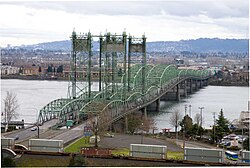Interstate Bridge | |
|---|---|
 Looking south from Vancouver | |
| Coordinates | 45°36′24″N 122°40′51″W / 45.6067°N 122.6808°W |
| Carries | 6 lanes of |
| Crosses | Columbia River |
| Locale | Portland, Oregon to Vancouver, Washington |
| Maintained by | Oregon Department of Transportation |
| ID number | 01377, 07333 |
| Characteristics | |
| Design | Dual truss with vertical lifts |
| Total length | 3,538 ft (1,078 m) |
| Width | Northbound span 38 ft (12 m); southbound span 39 ft (12 m) |
| Height | 242 ft (74 m)[1] |
| Longest span | 531 ft (161.8 m) |
| Clearance below | 72 ft (21.9 m) at highest fixed span; 176 ft (53.6 m) at open lift span[2] |
| History | |
| Designer | Waddell & Harrington[2]: 110–112 |
| Opened | February 14, 1917[2][3](Northbound span), 1958 (Southbound span) |
Portland–Vancouver Highway Bridge | |
| Location | Portland, Oregon; Vancouver, Washington |
| Coordinates | 45°37′05″N 122°40′31″W / 45.61806°N 122.67528°W |
| Built | 1915–16[6] |
| MPS | Historic Bridges/Tunnels in Washington State TR |
| NRHP reference No. | 82004205[4][5] |
| Added to NRHP | July 16, 1982[4] |
| Statistics | |
| Daily traffic | 132,592 (2014)[7] |
The Interstate Bridge (also Columbia River Interstate Bridge, I-5 Bridge, Portland-Vancouver Interstate Bridge, Vancouver-Portland Bridge) is a pair of nearly identical steel vertical-lift, Parker through-truss bridges that carry Interstate 5 traffic over the Columbia River between Vancouver, Washington and Portland, Oregon in the United States.
The present-day northbound bridge opened to traffic in 1917 as a single bridge carrying two-way traffic. A second twin bridge, which carries southbound traffic, opened in 1958.[2] The twin bridges are each over 3,500 feet (1,067 m) long and carry three lanes of traffic. The bridges handle a combined 130,000 vehicles daily.[2] It was added to the National Register of Historic Places in 1982, as the "Portland–Vancouver Highway Bridge".[4]
Since 2005, several proposals for replacing the bridge have been produced and debated. The bridge is considered responsible for traffic congestion of both road and river vehicles. Plans for a replacement bridge, known as the Columbia River Crossing (CRC) project, estimated to cost at least $3.4 billion, had come together by 2012 after many delays, but were very controversial, with both strong support and strong opposition.[8] In late June 2013, the CRC project was canceled, after the Washington state legislature declined to authorize funding for the project.[8] The Interstate Bridge Replacement Program, a joint effort between ODOT, WSDOT, Federal Highway Administration, Federal Transit Administration, Metro, Southwest Washington Regional Transportation Council, the cities of Portland and Vancouver, the Port of Portland, and the Port of Vancouver USA, was relaunched in 2017.
- ^ "ASR Registration 1248957".
- ^ a b c d e Wood Wortman, Sharon; Wortman, Ed (2006). The Portland Bridge Book (3rd ed.). Urban Adventure Press. pp. 107–112. ISBN 0-9787365-1-6.
- ^ Cite error: The named reference
formally openedwas invoked but never defined (see the help page). - ^ a b c "Oregon National Register List" (PDF). Oregon Parks and Recreation Department. June 6, 2011. p. 39. Archived from the original (PDF) on June 9, 2011. Retrieved July 13, 2011.
- ^ "National Register Information System". National Register of Historic Places. National Park Service. April 15, 2008.
- ^ Cite error: The named reference
bottenbergwas invoked but never defined (see the help page). - ^ "Columbia River Bridges: Crossing Data, 1961 - 2014". Retrieved June 25, 2015.
- ^ a b Read, Richard (July 1, 2013) [online date June 30]. "Cheers, dismay over CRC's demise". The Oregonian. p. 1. Retrieved July 7, 2013.

